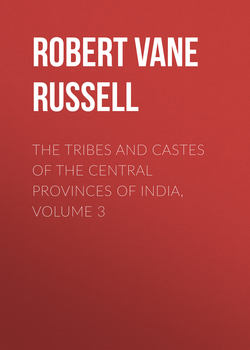Читать книгу The Tribes and Castes of the Central Provinces of India, Volume 3 - Robert Vane Russell - Страница 37
Gond
(c) Marriage Customs
19. Wedding expenditure
ОглавлениеIn Bastar it is said that the expenses of a wedding vary from Rs. 5 to Rs. 20 for the bride’s family and from Rs. 10 to Rs. 50 for the bridegroom’s, according to their means.61 In a fairly well-to-do family the expenditure of the bridegroom’s family is listed as follows: liquor Rs. 20, rice Rs. 12, salt Rs. 2, two goats Rs. 2, chillies Rs. 2, ghī Rs. 4, turmeric Rs. 2, oil Rs. 3, three cloths for the bride Rs. 8, two sheets and a loin-cloth for her relatives Rs. 5, payment to the Kumhār for earthen pots Rs. 5, the bride-price Rs. 10, present to the bride’s maternal uncle when she is not married to his son Rs. 2, and something for the drummers. The total of this is Rs. 76, and any expenditure on ornaments which the family can afford may be added. In wealthier localities the bride-price is Rs. 15 to 20 or more. Sometimes if the girl has been married and dies before the bride-price has been paid, her father will not allow her body to be buried until it is paid. The sum expended on a wedding probably represents the whole income of the family for at least six months, and often for a considerably longer period. In Chānda62 the bride’s party on arrival at the bridegroom’s village receive the Bara jawa or marriage greeting, every one present being served with a little rice-water, an onion and a piece of tobacco. At the wedding the bridegroom has a ring either of gold, silver or copper, lead not being permissible, and places this on the bride’s finger. Often the bride resists and the bridegroom has to force her fist open, or he plants his foot on hers in order to control her while he gets the ring on to her finger. Elsewhere the couple hold each other by the little fingers in walking round the marriage-post, and then each places an iron ring on the other’s little finger. The couple then tie strings, coloured yellow with turmeric, round each other’s right wrists. On the second day they are purified with water and put on new clothes. On the third day they go to worship the god, preceded by two men who carry a chicken in a basket. This chicken is called the Dhendha or associate of the bridal couple, and corresponds to the child which in Hindu marriages is appointed as the associate of the bridegroom. Just before their arrival at the temple the village jester snatches away the chicken, and pretends to eat it. At the temple they worship the god, and deposit before him the strings coloured with turmeric which had been tied on their wrists. In Chhindwāra the bride is taken on a bullock to the bridegroom’s house. At the wedding four people hold out a blanket in which juāri, lemons and eggs are placed, and the couple walk round this seven times, as in the Hindu bhānwar ceremony. They then go inside the house, where a chicken is torn asunder and the blood sprinkled on their heads. At the same time the bride crushes a chicken under her foot. In Mandla the bride on entering the marriage-shed kills a chicken by cutting off its head either with an axe or a knife. Then all the gods of her house enter into her and she is possessed by them, and for each one she kills a chicken, cutting off its head in the same manner. The chickens are eaten by all the members of the bride’s party who have come with her, but none belonging to the bridegroom’s party may partake of them. Here the marriage-post is made of the wood of the mahua tree, round which a toran or string of mango leaves is twisted, and the couple walk seven times round this. In Wardha the bride and bridegroom stand on the heap of refuse behind the house and their heads are knocked together. In Bhandāra two spears are placed on the heap of refuse and their ends are tied together at the top with the entrails of a fowl. The bride and bridegroom have to stand under the spears while water is poured over them, and then run out. Before the bride starts the bridegroom must give her a blow on the back, and if he can do this before she runs out from the spears it is thought that the marriage will be lucky. The women of the bride’s and bridegroom’s party also stand one at each end of a rope and have a competition in singing. They sing against each other and see which can go on the longest. Brāhmans are not employed at a Gond wedding. The man who officiates is known as Dosi, and is the bridegroom’s brother-in-law, father’s sister’s husband or some similar relative. A woman relative of the bride helps her to perform her part and is known as Sawāsin. To the Dosi and Sawāsin the bride and bridegroom’s parties present an earthen vessel full of kodon. The donors mark the pots, take them home and sow them in their own fields, and then give the crop to the Dosi and Sawāsin.
61
One rupee = 1s. 4d.
62
From Mr. Langhorne’s monograph.
